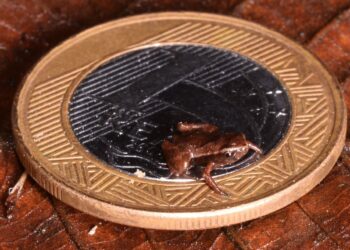Can you tell the difference between a frog and a toad? You might think that it’s easy, toads are warty and frogs have smooth, slimy skin. However, it’s not always as straightforward as it seems.
In general, there are some key differences between toads and frogs that make it possible to distinguish between them quite easily. If you’ve seen a frog, it’s probably been in or near a pond, while you’re more likely to encounter toads in drier areas. Toads crawl, have bumpy skin, and usually lay their eggs in large strands. Frogs jump around, have smooth skin, and lay their eggs in clumps. There are a few more physical differences that aren’t possible to spot so easily: toads have poison glands behind their eyes, distinctive chest cartilage, and lack teeth.

What we consider toads are the “true toads”, which are part of a single family, Bufonidae, made up of 600 species. Most of them have the typical traits that we expect in toads. However, there are over 7,000 species of toads and frogs in the world and it can easily get quite confusing to know what is a frog and what is a toad. They have similar features because they both make up the order Anura in the animal kingdom. Toads actually make up one group of frogs, so all toads are frogs, but not all frogs are toads.

Not all frogs and toads look or behave how we expect them. Some frogs look like toads with plain, bumpy skin, and some toads have smooth, brightly coloured skin. For example, the Harlequin Toads (genus Atelopus) are “true toads”, but you might think that they are frogs on first glance, because they are coloured in rich jewel shades and have smooth skin. They are often called frogs.
On the other hand, there are also frogs that get lumped in as “toads” just because they don’t adhere to typical frog beauty standards. This means that they could be drab-looking, have bumpy skin, and live more on land than near water. Indeed, hundreds of frogs from many different families, such as the Australian ground frogs (Myobatrachidae), fire-belly toads (Bombinatoridae), and the Asian toads (Megophryidae), get called toads although they are not.

It can get confusing because the names “frog” and “toad” are used interchangeably in the common names for amphibians. For example, Bombina bombina is a frog but its common names include European fire-bellied toad, ringing frog, fiery toad, and fire frog. Therefore, some frogs are called toads although they are not, just because they look similar. The reverse also occurs, as Harlequin toads are often called Harlequin frogs. However, the easiest way to know is to look at the scientific family. If its in Bufonidae, it’s a “true toad”.
All in all, “true toads” are the only official toads and can usually be distinguished by their appearance. However, there are also some froggy toads and toady frogs.






